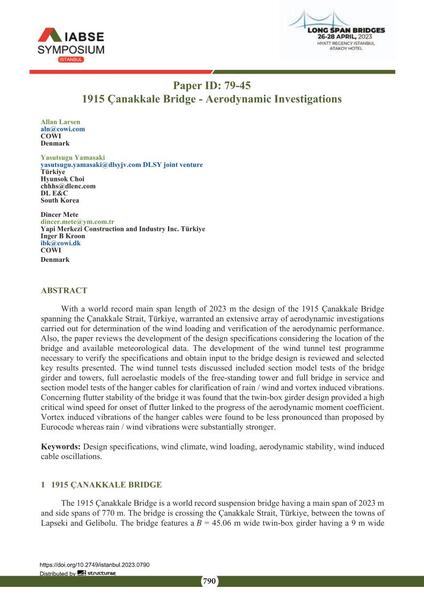1915 Çanakkale Bridge - Aerodynamic Investigations

|
|
|||||||||||
Bibliografische Angaben
| Autor(en): |
Allan Larsen
(COWI, Denmark)
Yasutsugu Yamasaki (DLSY joint venture T�rkiye ) Hyunsok Choi (DL E&C, South Korea) Dincer Mete (Yapi Merkezi Construction and Industry Inc. T�rkiye ) Inger B. Kroon (COWI, Denmark ) |
||||
|---|---|---|---|---|---|
| Medium: | Tagungsbeitrag | ||||
| Sprache(n): | Englisch | ||||
| Tagung: | IABSE Symposium: Long Span Bridges, Istanbul, Turkey, 26-28 April 2023 | ||||
| Veröffentlicht in: | IABSE Symposium Istanbul 2023 | ||||
|
|||||
| Seite(n): | 790-797 | ||||
| Anzahl der Seiten (im PDF): | 8 | ||||
| Jahr: | 2023 | ||||
| DOI: | 10.2749/istanbul.2023.0790 | ||||
| Abstrakt: |
With a world record main span length of 2023 m the design of the 1915 Çanakkale Bridge spanning the Çanakkale Strait, Türkiye, warranted an extensive array of aerodynamic investigations carried out for determination of the wind loading and verification of the aerodynamic performance. Also, the paper reviews the development of the design specifications considering the location of the bridge and available meteorological data. The development of the wind tunnel test programme necessary to verify the specifications and obtain input to the bridge design is reviewed and selected key results presented. The wind tunnel tests discussed included section model tests of the bridge girder and towers, full aeroelastic models of the free-standing tower and full bridge in service and section model tests of the hanger cables for clarification of rain / wind and vortex induced vibrations. Concerning flutter stability of the bridge it was found that the twin-box girder design provided a high critical wind speed for onset of flutter linked to the progress of the aerodynamic moment coefficient. Vortex induced vibrations of the hanger cables were found to be less pronounced than proposed by Eurocode whereas rain / wind vibrations were substantially stronger. |
||||
| Stichwörter: |
Windlast
|
||||
